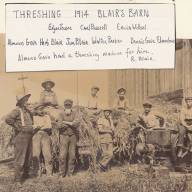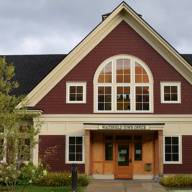The class of 1922 (1923) was a pretty large group compared to the class of 1952, that had nine kids enrolled. And it is mentioned in the book, they were extraordinarily serious about their classwork and extracurricular activities. It was not uncommon for youngsters from towns outside of Waitsfield to board with other families when school was in session.
The students that made it to graduation chose a copy of the painting “Pilgrims Going to Church” for their parting gift to the school. Why? Helen Reed wrote, “We have spent many happy hours here together, and as our time to part is drawing near, we wish to express our gratitude to our classmates and teachers for all that has been done for us.
“Through the four long years we have spent in Waitsfield High School, we have always tried to do something or give something that will benefit others as well as ourselves.
“We have succeeded so far to our greatest possible measure, and as a parting gift we present to Waitsfield High this picture, “The Pilgrims Going to Church” by Boughton.
“May it ever inspire you to be steadfast and true.”
Steadfast and true. Steadfast meaning committed and dedicated. True, as in genuine, sincere, and authentic. These are two descriptors that seem to have fallen out of favor in recent times, making Helen’s statement even more interesting. And her report, “…we have always tried to do something or give something that will benefit others as well as ourselves.”
I have heard elders of our community describe a time when the population of the Mad River Valley was so few they simply had to rely on each other for help. Help in the fields, help building, when a family member was sick and, yes, when a child needed a safe place to stay so they could attend Waitsfield junior and senior high school. These were clearly important values of the early 1920s in The Valley towns.
In a recent interview with the four eldest Hartshorn siblings, who were all kind enough to sit down with me, they talked about this heightened degree of a sense of community. It sounded as if The Valley was like an extended family who didn’t need to be asked to lend a hand. It was, in fact, part of a lifestyle. And when I asked each of them to tell me something they wish they could change for the current generation — they wished for an effort to bring that degree of caring and concern back into our fold. That we might teach our kids to value and provide aid to our neighbors.
This is from the history section of the 2007 Waitsfield Telecom phone book. It is written by Jan Pogue about George Wallis.
Ultimately, that restiveness and desire to offer better education to the community fueled a major event in the history of the Mad River Valley: he almost single-handedly brought a four-year high school to Waitsfield in 1921, in the form of what is sometimes teasingly referred to as the “George Wallis Temple of Learning.”
Education was taken seriously in the community, but problems existed. Truancy was clearly a huge issue, and one that caused school leaders a great deal of bitterness. Fayston superintendent Merle H. Willis in the 1923 town report chastised in capital letters parents who didn’t make sure their children were in school: “Many cases of truancy are reported but no great improvement can be expected unless public sentiment in the town demands it.” Willis went on to list “the damage from truancy (in) forming of vicious habits of irresponsibility,” and to note that the entire community suffered from “the direct financial loss to the taxpayer as he is not getting the results from his money that he has a right to expect.”
Warren’s superintendent, Laura Goodspeed, sounded the same alarm in a 1908 town report in which she pointed out there had been 31 cases of truancy during the previous school year which “show how little interest some parents take in the education of their children.” Displaying obvious knowledge of her community, she went on to point out, “At the same time that they (parents) were keeping their own children at home, they were so anxious that their neighbor’s children should be well educated, that they reported them to the truant officer if absent from school for a single day.”
You can reach me at












